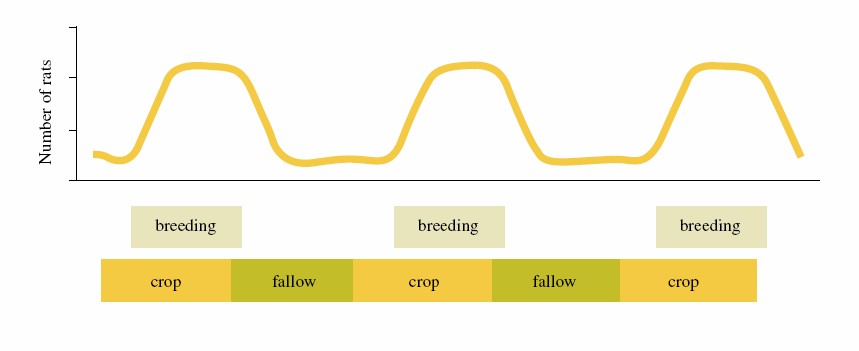A publication from ACIAR (Australian Centre for International Agricultural Research) described a method of controlling rodents in lowland irrigated rice crops without the use of chemicals. The publication is a Research Note describing Community Trap Barrier Systems (CTBS). These systems are large cages (20 to 50 meters square) made of plastic, bamboo or wooden stakes, string or wires, staples, and rat traps (see Figure 1). The cages are strategically constructed within a crop field and a trap crop (often an early-maturing rice variety) is planted within the cage. The cage is encircled by a moat, and specific mounded entrances lead to live-traps. The lure crop attracts rats from surrounding fields as far as 200 m away. A single CTBS can protect an area of 10 to 15 hectares.
One of the most interesting aspects of the ACIAR Research Note is a discussion of rodent breeding biology and its relationship to the growth of a rice crop. Here is an excerpt from the publication: “Breeding in ricefield rats [Rattus argentiventer and Rattus losea] appears to be triggered by the maturation of the rice plant itself, with females first entering oestrous 1-2 weeks prior to maximum tillering. After a short pregnancy of 3 weeks, litters of up to 18 pups (average of 1112 pups) are produced. The pups grow rapidly and are ready to breed at 6 weeks of age. Adult females are able to fall pregnant again within a few days of giving birth, and therefore can produce three litters during the generative phase of the rice crop—a total of 30-40 young rats for each original female by harvest time.
“The number of breeding seasons per year is also linked to the number of cropping cycles. A single rice crop per year results in one rat breeding season, two crops results in two rat breeding seasons etc. (Figure 2).
“…Where harvest is staggered by more than one or two weeks within a single cropping area, the rat population will move from field to field, causing increasingly severe damage in the later-harvested crops. Even more critically, rats born during the early part of the cropping season will themselves be old enough to start breeding before harvest is completed. This can produce a sudden explosion in rat numbers. Instead of one female producing 30-40 young, she and her offspring will produce 100-120 young.”


In practical terms, this means that killing a female rat before or during the breeding season before her first litter is weaned (at the milky stage of rice) is equivalent to killing 30-40 rats just before harvest. Also, fields in a particular area should be harvested within two weeks of each other to avoid a situation in which rats simply move from one field to another for food. An extended fallow period often results in a rapid decline in the local rat population.
A CTBS is most successful when it is implemented within a whole community rather than just by an individual. This is because rats can travel great distances in search of food and thus will reinfest a crop from an unprotected area.
CTBS will be most cost-effective if crop damage from rodents is expected to be 10% or higher, if the cages are well-made and maintained, and if it is adopted by an entire community. Experiments done in Indonesia and Vietnam have shown increases in rice production of 0.3 to 1 tonne per hectare within the area 200 m from the cage in all directions. In these two countries, materials for each CTBS unit cost around US$25-50. Materials can usually be reused for 2 to 4 seasons.
CTBS will be most cost-effective if crop damage from rodents is expected to be 10% or higher, if the cages are well-made and maintained, and if it is adopted by an entire community. Experiments done in Indonesia and Vietnam have shown increases in rice production of 0.3 to 1 tonne per hectare within the area 200 m from the cage in all directions. In these two countries, materials for each CTBS unit cost around US$25-50. Materials can usually be reused for 2 to 4 seasons.
A few other ideas (in addition to the CTBS) were given for controlling rodents in rice fields. For example, bunds should be kept low and less than 30 cm wide to make it difficult for rats to burrow. Rat burrows should be located and destroyed when rice is in the tillering stage [producing multiple stems]. Rodents should be trapped within two weeks of when the crop is planted.
If you are interested in obtaining instructions to build a CTBS, please write to us for a copy of the ACIAR Research Note. The document is also available on the web at: http://aciar.gov.au/files/node/2212/rn26.pdf
Comments:
Cite as:
Berkelaar, D. 2006. A Non-chemical Method of Rat Control for Rice Fields. ECHO Development Notes no. 93